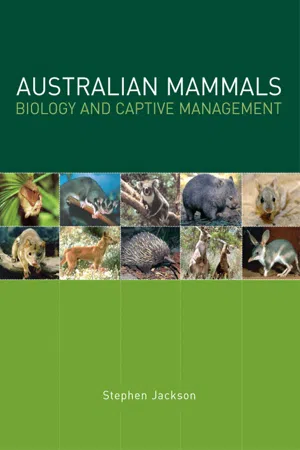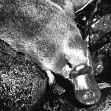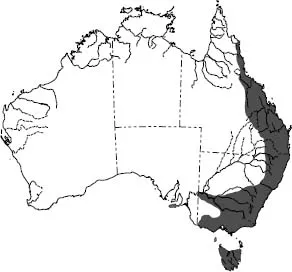![]()
1 PLATYPUS
Stephen Jackson,
Melody Serena and
David Middleton
1. Introduction
The platypus and the echidnas, that make up the Australian monotremes, are unique mammals due to their egg laying, appearance and lifestyles and are of enormous community and scientific interest. In particular, the unique features and secretive lifestyle of the platypus have made it a longstanding focus of attention.
Platypus appear to have been first held in captivity by Maule (1832) in 1831 who captured a female and two young that lived for two weeks on worms, bread and milk. In 1832 and 1833 Bennett (1834a, 1834b) held several animals including two young that survived five weeks on bread soaked in water, chopped egg and finely minced meat. Subsequently, platypus were held by Verreaux (1848) who fed them a diet of rice and egg yolk, while Burrell (1927) was the first person to display them to the Australian public – in 1910 for three months at the Sydney Zoological Gardens when it was at Moore Park (prior to its move where it became Taronga Zoo). Budapest Zoo was the first overseas zoo to receive a live animal in 1913 when two animals were sent there (Collins 1973). In 1922 an animal was transferred to New York Zoological Park where it lived for 49 days and was on display for one hour per day (Joseph 1922; Burrell 1927). The only other platypus sent overseas was in 1947 and 1958 when a male and two females were sent (on each occasion) to the New York Zoological Society (Fleay 1980). Early attempts to keep platypus in captivity resulted in them dying after only a few weeks or months, and it was not until 1932 that the first long-term maintenance and display of platypus occurred at Healesville Sanctuary, Victoria, Australia when an animal was kept for several years (Eadie 1935). Little effort was spent attempting to breed platypus until the success of Fleay (1944) in the summer of 1943/44 at Healesville Sanctuary. Although platypus have been maintained for extended periods in a number of institutions in recent years, in a truly captive environment, successful breeding resulting in live young is very rare. Since platypus first came into captivity until the end of 2002/2003 breeding season, captive platypus have only been bred successfully on three other occasions (Holland and Jackson 2002; A. Battaglia and M. Hawkins pers. comm.; pers. obs.). Today only seven Australian zoos maintain platypus (Lees and Johnson 2002; pers. obs.).
Platypus exhibits and management of the species follow similar lines in institutions across Australia, however, new approaches are continually being developed and used as more information on platypus husbandry and biology becomes available.
Captive management of platypus has an essential role to play in biological research as well as conservation-based educational displays. At the same time, the perceived poor survival of captive platypus has generated concern amongst managers, researchers, conservationists and the general community. Accordingly, there is a need to ensure that impeccable standards for captive management of platypus are developed. Whilst many standards may be universally applicable it would be false to say that we have the definitive ‘recipe’ for exhibiting, maintaining and breeding platypus in captivity.
2. Taxonomy
2.1 Nomenclature
The platypus was originally described as Platypus anatinus by Shaw (1799). However as that name was already used for a genus of beetles, the term Ornithorhynchus was used. This is the name used by Blumenbach (1800) to describe the platypus when he called it Ornithorhynchus paradoxus.
Class: Mammalia
Subclass: Prototheria
Order: Monotremata
Family: Ornithorhynchidae
Genus species: Ornithorhynchus anatinus
Etymology
Ornithorhynchus – bird snout
anatinus – duck like
Platypus – flat foot
2.2 Subspecies
None
2.3 Recent synonyms
Synonyms of the platypus can be found in Mahoney (1988).
2.4 Other common names
In the past it has been called a water mole.
3. Natural history
3.1 Morphometrics
The platypus is one of Australia’s most easily recognisable animals. It is approximately 40–50 cm long, has a dense waterproof fur over all of its body except the bill and feet, and a bill that is soft and pliable. It has webbed feet and the males possess a venomous spur on the inside of their hind legs.
Size varies with location, with a general north to south cline variation in body size, the smallest animals being found in Queensland and the largest ones in New South Wales west of the Divide and in Tasmania (Carrick 1995; Connolly and Obendorf 1998). Length is measured from tip of bill to tip of tail (Carrick 1995) (Table 1). There is a distinct sexual dimorphism with males being larger and heavier than females. The platypus is easily distinguished from all other mammals by its soft flexible bill, webbed feet and aquatic lifestyle.
3.2 Distribution and habitat
The platypus occurs in freshwater streams along the east coast of Australia from north Queensland to South Australia (including Kangaroo Island, where they were introduced) and Tasmania (including King Island) and in streams running westward from the Great Dividing Range (Fig. 1).
It is also found in occasionally brackish streams, creeks, lakes and ponds. These vary from shallow creeks with pools and riffles to large deep rivers. When out of the water, platypus live in burrows that are dug into the bank of the water body. Burrows are usually short and simple in construction with the entrance either above or below the water level, and often under a tangle of tree roots (Carrick 1995).
3.3 Conservation status
Throughout its distribution the platypus is relatively common and considered to be at low risk of extinction.
3.4 Diet in the wild
In the wild, platypus feed on a wide variety of freshwater adult and larval invertebrates including dragonflies and caddisflies (Table 2). The platypus has a complex bill apparatus that it uses to sift smaller prey items. Platypus appear to find their food by detecting the weak electrical impulses of invertebrates when they move their exoskeletons. Once food is picked up and sifted, it is stored in cheek pouches, and is then thoroughly masticated while the animal floats on the surface of the water.
Table 1. Body length and weight for different locations in Australia.
Figure 1. Distribution of the platypus. After Grant (1995) with permission of UNSW Press.
3.5 Longevity
3.5.1 Wild
Capture information from the Shoalhaven River has shown that a female who was captured as an adult was at least 15 years old and one captured as a juvenile is at least 16 years old. Four males in the population that were captured as adults were over six years of age and another animal was captured as a juvenile seven years ago (T. Grant pers. comm.).
3.5.2 Captivity
In captivity platypus have been known to live for very long periods. Lone Pine Ko...



